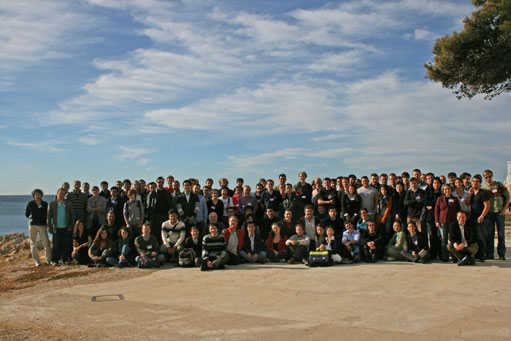
ATLAS e-News
23 February 2011
How well do we know electrons and photons?
15 November 2010

Attendees at the e/gamma workshop, organised by the Centre de Physique des Particles de Marseille
At the start of November, Carry-le-Rouet near Marseille played host to the third annual e/gamma workshop. Reflecting upon the identification and reconstruction of electrons and photons, 120 participants came together from many areas of ATLAS.
“Of course it was very exciting because it was the first [e/gamma workshop] with data,” considers working group co-convenor, Fabrice Hubaut. “Last year the workshop was really focussed on preparations for data taking; this year, the focus was on understanding the data we have and on preparing for the future.”
Representing, as they do, the synapse between detector specialists and physics groups, a lot of people are involved in and interested in what the combined performance working groups have to say. At the workshop, calorimeter and Inner Detector experts reported on what had gone well and not so well in relation to the reconstruction of electrons and photons, and physics groups presented their needs in terms of performance in these areas.
The first part of the meeting was spent reviewing the performance studies for the 2010 data. These are still a work in progress, since a large fraction of the year's data was collected immediately before the workshop. “But it was nice to see that we have a kind of synthesis of all the studies that are ongoing,” says Fabrice.
Another key element of the workshop was feeding back benchmark performances to physics groups – basically assessments of how far the ATLAS hardware and software can be trusted – to be applied in physics analyses: “[They] need to know from us what are the performances concerning the electron and photon reconstruction and identification. We have to give some recommendations to the physics groups on how to deal with these objects,” explains Fabrice, adding: “The workshop allowed us to advance on this.” ATLAS Collaborators can find further specific details here.
Looking ahead to the 2011 run took up the remainder of the timetable “because we understood from this year's data that of course things are not perfect”. Step one, fine-tuning the identification algorithms to make them better at their job, is already underway. “We need to optimise our identification criteria to reject more of the background compared to the signal. If we stay at the level where we are now, we know that with the luminosity that we may reach next year the trigger rate will be too high.”
Step two, which is taking place concurrently, is to try to improve the Monte Carlo simulation. “Based on this year's data, we discovered some imperfections in the simulation compared to data,” Fabrice explains, and so the identification criteria were adjusted early in the run. This temporary change to account for the simulation differences meant a slightly lower electron ID performance. Tuning the simulation will therefore help in the re-optimisation of the identification algorithms.
As incoming co-convenor of the e/gamma group, Fabrice was most struck by the breadth and scope of information transferred at the meeting: “It's amazing to see all these people and to have a review of all the studies ongoing within this group!”
A lot has happened since the last e/gamma workshop a year ago, and there was much discussion of the timetabled variety inside the venue as well as plenty more during more relaxed moments in the beautiful local setting. Overall though, says Fabrice: “There are no major surprises; [we see] quite good agreement between data and Monte Carlo simulations at this stage.”
 Ceri PerkinsATLAS e-News
|